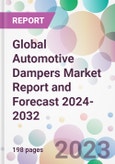According to the report, the global automotive dampers market is projected to grow at a CAGR of 2.10% between 2024 and 2032 reaching a value of approximate USD 5.6 billion by 2032. Aided by the technological advancements in vehicle suspension systems and the escalating demand for comfort and safety in vehicles, the market is expected to grow significantly by 2032.
Automotive dampers, often referred to as shock absorbers, are an integral component of a vehicle's suspension system. They play a pivotal role in enhancing ride comfort, stability, and safety by absorbing and dissipating energy from road irregularities and vehicle dynamics. Beyond their primary function of cushioning the impacts, modern dampers also contribute significantly to optimizing road grip, ensuring steering accuracy, and minimising stopping distances.
One of the primary catalysts for automotive dampers market growth is the ever-increasing consumer demand for enhanced vehicle comfort and safety. As global road networks expand and the average commute time rises, ensuring a smooth driving experience has become paramount for manufacturers. Additionally, with heightened awareness about vehicular safety, the efficacy of dampers in preventing accidents caused by skidding or loss of control is being widely recognised, further augmenting their demand.
As per the automotive dampers market analysis, technological innovations in the realm of vehicle suspension systems are driving the evolution of the market. The rise in adaptive and active damping systems, which adjust damping characteristics in real-time based on driving conditions, signifies the industry's progression. Such advancements ensure optimal performance in diverse driving conditions, from city commutes to off-roading adventures.
The automotive industry's inclination towards lightweighting, aiming to enhance fuel efficiency and reduce emissions, is also positively impacting the automotive dampers market demand. Innovations in material science have led to the development of lightweight damper components without compromising their performance, aligning with the industry's sustainability goals.
Furthermore, the global shift towards electric vehicles (EVs) presents lucrative opportunities for the market. As the dynamics and weight distribution in EVs differ from conventional vehicles due to battery placements, there's a pressing need for specialised dampers to cater to these unique challenges. The rapid proliferation of EVs worldwide is, thus, expected to increase the automotive dampers market size.
Automotive dampers, often referred to as shock absorbers, are an integral component of a vehicle's suspension system. They play a pivotal role in enhancing ride comfort, stability, and safety by absorbing and dissipating energy from road irregularities and vehicle dynamics. Beyond their primary function of cushioning the impacts, modern dampers also contribute significantly to optimizing road grip, ensuring steering accuracy, and minimising stopping distances.
One of the primary catalysts for automotive dampers market growth is the ever-increasing consumer demand for enhanced vehicle comfort and safety. As global road networks expand and the average commute time rises, ensuring a smooth driving experience has become paramount for manufacturers. Additionally, with heightened awareness about vehicular safety, the efficacy of dampers in preventing accidents caused by skidding or loss of control is being widely recognised, further augmenting their demand.
As per the automotive dampers market analysis, technological innovations in the realm of vehicle suspension systems are driving the evolution of the market. The rise in adaptive and active damping systems, which adjust damping characteristics in real-time based on driving conditions, signifies the industry's progression. Such advancements ensure optimal performance in diverse driving conditions, from city commutes to off-roading adventures.
The automotive industry's inclination towards lightweighting, aiming to enhance fuel efficiency and reduce emissions, is also positively impacting the automotive dampers market demand. Innovations in material science have led to the development of lightweight damper components without compromising their performance, aligning with the industry's sustainability goals.
Furthermore, the global shift towards electric vehicles (EVs) presents lucrative opportunities for the market. As the dynamics and weight distribution in EVs differ from conventional vehicles due to battery placements, there's a pressing need for specialised dampers to cater to these unique challenges. The rapid proliferation of EVs worldwide is, thus, expected to increase the automotive dampers market size.
Market Segmentation
The market can be divided based on application and region.Market Breakup by Application
- Passenger Vehicles
- Commercial Vehicles
Market Breakup by Region
- North America
- Europe
- Asia Pacific
- Latin America
- Middle East and Africa
Competitive Landscape
The report looks into the market shares, plant turnarounds, capacities, investments, and mergers and acquisitions, among other major developments, of the leading companies operating in the global automotive dampers market. Some of the major players explored in the report are as follows:- Hitachi Automotives Systems, Ltd.
- Magneti Marelli S.p.a
- Mando American Corporation
- Showa Corporation
- Tenneco Inc. (NYSE: TEN)
- ZF Friedrichshafen AG
- Others
Table of Contents
1 Preface2 Report Coverage - Key Segmentation and Scope4 Key Assumptions7 Opportunities and Challenges in the Market15 Value Chain Analysis17 Key Trends and Developments in the Market
3 Report Description
5 Executive Summary
6 Snapshot
8 Global Automotive Dampers Market Analysis
9 North America Automotive Dampers Market Analysis
10 Europe Automotive Dampers Market Analysis
11 Asia Pacific Automotive Dampers Market Analysis
12 Latin America Automotive Dampers Market Analysis
13 Middle East and Africa Automotive Dampers Market Analysis
14 Market Dynamics
16 Competitive Landscape
List of Key Figures and Tables
Companies Mentioned
- Hitachi Automotives systems ltd
- Magneti Marelli S.p.a
- Mando American Corporation
- Showa Corporation
- Tenneco Inc.
- ZF Friedrichshafen AG
Methodology

LOADING...








